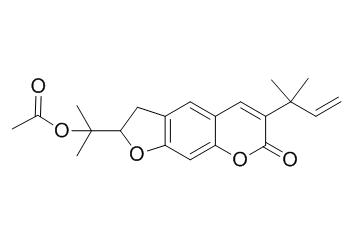Rutamarin
(+)-Rutamarin is effective in inhibiting EBV DNA replication and virion production but shows little adverse effect on cell proliferation.It is a dual inducer of both GLUT4 translocation and expression efficiently ameliorates glucose homeostasis in insulin-resistant mice. Rutamarin exhibits remarkable cytotoxic activity against HT29 cells (IC50 value of 5.6 uM), it has the potential to be developed as an anticancer agent.
Inquire / Order:
manager@chemfaces.com
Technical Inquiries:
service@chemfaces.com
Tel:
+86-27-84237783
Fax:
+86-27-84254680
Address:
1 Building, No. 83, CheCheng Rd., Wuhan Economic and Technological Development Zone, Wuhan, Hubei 430056, PRC
Providing storage is as stated on the product vial and the vial is kept tightly sealed, the product can be stored for up to
24 months(2-8C).
Wherever possible, you should prepare and use solutions on the same day. However, if you need to make up stock solutions in advance, we recommend that you store the solution as aliquots in tightly sealed vials at -20C. Generally, these will be useable for up to two weeks. Before use, and prior to opening the vial we recommend that you allow your product to equilibrate to room temperature for at least 1 hour.
Need more advice on solubility, usage and handling? Please email to: service@chemfaces.com
The packaging of the product may have turned upside down during transportation, resulting in the natural compounds adhering to the neck or cap of the vial. take the vial out of its packaging and gently shake to let the compounds fall to the bottom of the vial. for liquid products, centrifuge at 200-500 RPM to gather the liquid at the bottom of the vial. try to avoid loss or contamination during handling.
Compounds.2023, 3(1), 169-179.
Front Immunol.2017, 8:1542
Vietnam J. Chem.2023, 61(3),308-317
Nat Commun.2023, 14(1):5075.
Food and Bioprocess Technology2017, 10(6):1074-1092
Int J Mol Sci.2024, 25(18):9909.
Agronomy2023, 13(9), 2410.
Korean Herb. Med. Inf.2021, 9(2):231-239.
Molecules2020, 25(4):892
Hanoi University of Pharmacy2023, 14(1):30-39.
Related and Featured Products
Pharmacogn Mag. 2017 Jul;13(Suppl 2):S179-S188.
Rutamarin, an Active Constituent from Ruta angustifolia Pers., Induced Apoptotic Cell Death in the HT29 Colon Adenocarcinoma Cell Line.[Pubmed:
28808378]
Ruta angustifolia Pers. is a perennial herb that is cultivated worldwide, including Southeast Asia, for the treatment of various diseases as traditional medicine. The purpose of the study was to identify an active principle of R. angustifolia and to investigate its effect on the HT29 cell death.
METHODS AND RESULTS:
The methanol and fractionated extracts (hexane, chloroform, ethyl acetate, and water) of R. angustifolia Pers. were initially investigated for their cytotoxic activity against two human carcinoma cell lines (MCF7 and HT29) and a normal human colon fibroblast cell line (CCD-18Co) using sulforhodamine B cytotoxicity assay. Eight compounds including Rutamarin were isolated from the active chloroform extract and evaluated for their cytotoxic activity against HT29 human colon carcinoma cell line and CCD-18Co noncancer cells. Further studies on the induction of apoptosis such as morphological examinations, biochemical analyses, cell cycle analysis, and caspase activation assay were conducted in Rutamarin-treated HT29 cells. Rutamarin exhibited remarkable cytotoxic activity against HT29 cells (IC50 value of 5.6 μM) but was not toxic to CCD-18Co cells. The morphological and biochemical hallmarks of apoptosis including activation of caspases 3, 8, and 9 were observed in Rutamarin-treated HT29 cells. These may be associated with cell cycle arrest at the G0/G1 and G2/M checkpoints, which was also observed in HT29 cells.
CONCLUSIONS:
The present study describes Rutamarin-induced apoptosis in the HT29 cell line for the first time and suggests that Rutamarin has the potential to be developed as an anticancer agent.
Antiviral Res. 2014 Jul;107:95-101.
Antiviral activity of topoisomerase II catalytic inhibitors against Epstein-Barr virus.[Pubmed:
24821256 ]
Herpesviruses require several cellular proteins for their lytic DNA replication including topoisomerase II (Topo II). Thus, Topo II could be an effective drug target against herpesviral infection.
METHODS AND RESULTS:
In this study, we examined several Topo II catalytic inhibitors for their potentials in blocking EBV replication and becoming efficacious antiviral agents. Topo II catalytic inhibitors in general exhibited marked inhibition of EBV lytic replication and minimal cytotoxicity.
In particular, (+)-Rutamarin, with the best selectivity index (SI>63) among the inhibitors tested in this study, is effective in inhibiting EBV DNA replication and virion production but shows little adverse effect on cell proliferation, suggesting its potential to become an efficacious and safe drug for the treatment of human diseases associated with EBV infection.
PLoS One. 2012;7(2):e31811.
(+)-Rutamarin as a dual inducer of both GLUT4 translocation and expression efficiently ameliorates glucose homeostasis in insulin-resistant mice.[Pubmed:
22384078 ]
Glucose transporter 4 (GLUT4) is a principal glucose transporter in response to insulin, and impaired translocation or decreased expression of GLUT4 is believed to be one of the major pathological features of type 2 diabetes mellitus (T2DM). Therefore, induction of GLUT4 translocation or/and expression is a promising strategy for anti-T2DM drug discovery.
METHODS AND RESULTS:
Here we report that the natural product (+)-Rutamarin (Rut) functions as an efficient dual inducer on both insulin-induced GLUT4 translocation and expression. Rut-treated 3T3-L1 adipocytes exhibit efficiently enhanced insulin-induced glucose uptake, while diet-induced obese (DIO) mice based assays further confirm the Rut-induced improvement of glucose homeostasis and insulin sensitivity in vivo. Subsequent investigation of Rut acting targets indicates that as a specific protein tyrosine phosphatase 1B (PTP1B) inhibitor Rut induces basal GLUT4 translocation to some extent and largely enhances insulin-induced GLUT4 translocation through PI3 kinase-AKT/PKB pathway, while as an agonist of retinoid X receptor α (RXRα), Rut potently increases GLUT4 expression. Furthermore, by using molecular modeling and crystallographic approaches, the possible binding modes of Rut to these two targets have been also determined at atomic levels.
CONCLUSIONS:
All our results have thus highlighted the potential of Rut as both a valuable lead compound for anti-T2DM drug discovery and a promising chemical probe for GLUT4 associated pathways exploration.



